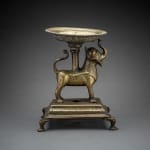Indian Incense Burner in the Form of an Elephant, 13th Century CE - 17th Century CE
Bronze
20.6 x 25.4 cm
8 1/8 x 10 in
8 1/8 x 10 in
LO.1400
Further images
Cast bronze incense burner in the form of an elephant standing upon integral rectangular base with four zoomorphic feet and openwork lobed cartouche at centre; cylindrical shaft emanates from back...
Cast bronze incense burner in the form of an elephant standing upon integral rectangular base with four zoomorphic feet and openwork lobed cartouche at centre; cylindrical shaft emanates from back of elephant forming support for detachable bowl with beveled rim; tooled decoration over whole.
This superb bronze incense burner was produced during a period of Muslim dominance in India. Having been established by Turko-Afghan tribes during 12th century, the Delhi Sultanate would extend Islam’s firm hold over India for the next 500 years. This period saw a succession of Turko-Afghan dynasties and the synethesis of Islamic and Indian culture; political institutions evolved in response to Indian conditions and Hindu rulers, if they paid fealty to the Sultans were welcome at royal activities. By 16th century Islamic and Indian elements reflected a balanced synthesis, which only grew stronger over time. Many Hindus spoke Persian and actively cultivated Iranian culture, even converting to Islam by marriage. This synthesis is naturally reflected and reiterated in the arts.
Metalwork was one of the major decorative arts of this period and we see the perpetration of Indo-Islamic forms initiated during the early Sultanate period.
The accentuated, near-feline form of the elephant finds parallels in the abstracted felines of contemporary Islamic metalwork, which themselves borrow heavily from the Persian tradition. A clear preference for stylization over naturalistic articulation is evident from, among other elements, the block treatment of the limbs, high undulating trunk and tail and twin pointy ears. The incised detailing, tooled rosettes and arabesque to the bowl similarly derive from both Islamic and pre-Islamic sources and articulate the spread of Central Asian stylistic influence in India.
The stark stylistic differences between this elephant and that of a Mughal incense burner of 17th century at British Museum appear to indicate this piece heralds from pre-Mughal India.
This superb bronze incense burner was produced during a period of Muslim dominance in India. Having been established by Turko-Afghan tribes during 12th century, the Delhi Sultanate would extend Islam’s firm hold over India for the next 500 years. This period saw a succession of Turko-Afghan dynasties and the synethesis of Islamic and Indian culture; political institutions evolved in response to Indian conditions and Hindu rulers, if they paid fealty to the Sultans were welcome at royal activities. By 16th century Islamic and Indian elements reflected a balanced synthesis, which only grew stronger over time. Many Hindus spoke Persian and actively cultivated Iranian culture, even converting to Islam by marriage. This synthesis is naturally reflected and reiterated in the arts.
Metalwork was one of the major decorative arts of this period and we see the perpetration of Indo-Islamic forms initiated during the early Sultanate period.
The accentuated, near-feline form of the elephant finds parallels in the abstracted felines of contemporary Islamic metalwork, which themselves borrow heavily from the Persian tradition. A clear preference for stylization over naturalistic articulation is evident from, among other elements, the block treatment of the limbs, high undulating trunk and tail and twin pointy ears. The incised detailing, tooled rosettes and arabesque to the bowl similarly derive from both Islamic and pre-Islamic sources and articulate the spread of Central Asian stylistic influence in India.
The stark stylistic differences between this elephant and that of a Mughal incense burner of 17th century at British Museum appear to indicate this piece heralds from pre-Mughal India.





